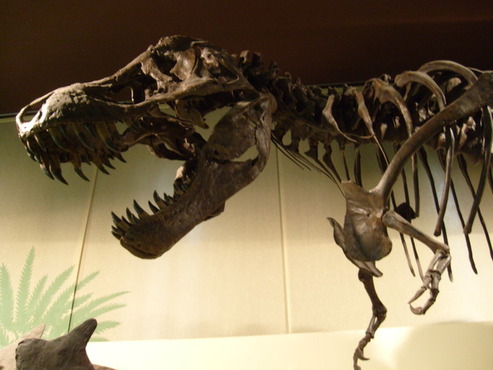Stefano Rossignoli 16 febbraio 2010
Anche oggi, al museo di Storia Naturale di Milano ho dovuto parlare dell’estinzione dei Dinosauri…
E il discorso comincia sempre allo stesso modo:”In quella grande estinzione, non si sono mica estinti solo i dinosauri, ma un numero enorme di specie appartenenti a innumerevoli famiglie di organismi…”.
Grazie alla documentazione fossile, assistiamo infatti a quella che viene chiamata un’Estinzione di Massa.
Più precisamente, l’estinzione che ha riguardato anche i dinosauri, è avvenuta circa 65 milioni di anni fa, alla fine del periodo Cretaceo (l’ultimo dell’era secondaria o mesozoica) e all’inizio dell’era terziaria o cenozoica (Vedi scala dei tempi geologici).
Dagli addetti ai lavori viene chiamata estinzione al limite K/T dove K sta per cretaceo e T per terziaria.
Ma cosa può aver provocato tale estinzione e con che ritmi è avvenuta? Qual’è stata la successione degli eventi?
Queste sono le domande che viene spontaneo porsi, ma come ben sapete, la documentazione fossile è un libro aperto sul passato a cui però mancano ancora moltissime pagine…
Innanzi tutto chi si è estinto al limite K/T?
Moltissime famiglie, ancor più generi e miriadi di specie animali e vegetali, terrestri e acquatiche e di sicuro non le conosciamo neanche tutte. Molluschi marini tra cui le Ammoniti, rettili volanti, rettili marini, coralli, organismi unicellulari…
I dinosauri sono ‘solo’ uno dei tanti gruppi di organismi che hanno subito questo evento.
In quanto tempo è avvenuta questa estinzione?
Un anno? Cento anni? Mille anni? Diecimila anni?
Vi sembrerà strano, ma come raccontavo in questo vecchio articolo(Un istante …Sì, ma in paleontologia), dire 1 o 10.000 è più o meno come dire la stessa cosa. Non siamo in grado di percepire le differenze di tempo con molta sensibilità. A volte ci si deve accontentare di andare di centomila, in centomila o addirittura di più. Vi sembrerà tantissimo, ma in confronto a decine di milioni di anni, non è poi così tanto!
Figuratevi se poi andiamo a parlare della più grande estinzione di sempre che è datata al limite Permiano/Triassico, circa 250 milioni di anni fa. La nostra capacità di percepire la successione degli eventi è letteralmente ridicola…
Per ora, le cause certe di queste due estinzioni non le conosciamo ancora ma conosciamo con buona certezza alcuni episodi che sono avvenuti all’epoca delle suddette estinzioni di massa.
Ad esempio in entrambi i casi, ci sono stati enormi impatti meteorici studiati, provati e documentati sia nel K/T che nel Permo/Trias.
Di sicuro è stata liberata una grossa quantità di energia… Pensate al botto che potrebbe fare la caduta di un meteorite di 10km di diametro o più.
…altro che Smallville e Superman!!!
Questo però non ci spiega come mai alcuni gruppi si siano estinti mentre altri gruppi del tutto analoghi abbiano continuato a vivere indisturbati.
Sappiamo anche che il clima è cambiato in entrambi i casi. Non sto parlando certo di glaciazioni. E’ una diceria che i Dinosauri si siano estinti a causa di un’era glaciale!!! Di sicuro però, a causa dei cambiamenti della posizione dei continenti, è cambiata la circolazione delle acque oceaniche e di conseguenza anche il clima che nell’era mesozoica è stato globalmente più caldo…
Ci sono documentazioni di eruzioni vulcaniche di enorme entità in corrispondenza delle estinzioni di massa.
Sia durante l’impatto di meteoriti che in conseguenza ad enormi eruzioni vulcaniche si può depositare una abbondante quantità di iridio, Il 77° elemento della tavola periodica.
Mi pare comunque inutile e assurdo cercare di spiegare la successione degli eventi.
Potrebbe essere caduto un meteorite e 50.000 anni dopo le eruzioni vulcaniche o viceversa, ma anche insieme o a maggior distanza temporale!
Mi sembra importante sottolineare quindi l’impossibilità di ricostruire la successione precisa degli eventi e poi soprattutto sottolineare che chiamare l’estinzione K/T ‘estinzione dei Dinosauri’ è un modo che fa scena, ma non fa scienza!
Di sicuro aumenta i contatti ad un sito e anche al mio! Figuratevi che io in questo articolo ci ho messo pure Smallville e Superman!!!
Detto questo bisogna riconoscere il fascino di questa teoria:
65 milioni di anni fa…
I Dinosauri dominano la terra ferma, i rettili occupano mari e cieli…probabilmente c’è stato il tempo per vederlo quel meteorite e per vederlo mentre si incendiava ed era già enorme visto da lontano. Figuriamoci da vicino! …no, non ci prenderà, non ci prenderà e invece…
Terremoto, qualcosa di mai sentito prima, Tzunami violentissimi e poi… I sopravvissuti al grande impatto vedono man mano oscurarsi il sole nel giro di settimane, mesi ed è sempre peggio.
Le piante non sono più in grado di fare la fotosintesi. Prima i vegetariani e poi di conseguenza anche i carnivori non riescono ad alimentarsi a sufficienza e a garantire cibo alla prole… E’ un inverno lunghissimo, almeno qualche anno senza che il sole passi attraverso la grande nube di ceneri vulcaniche sospesa nell’atmosfera…
Che bella storiella …appunto!
